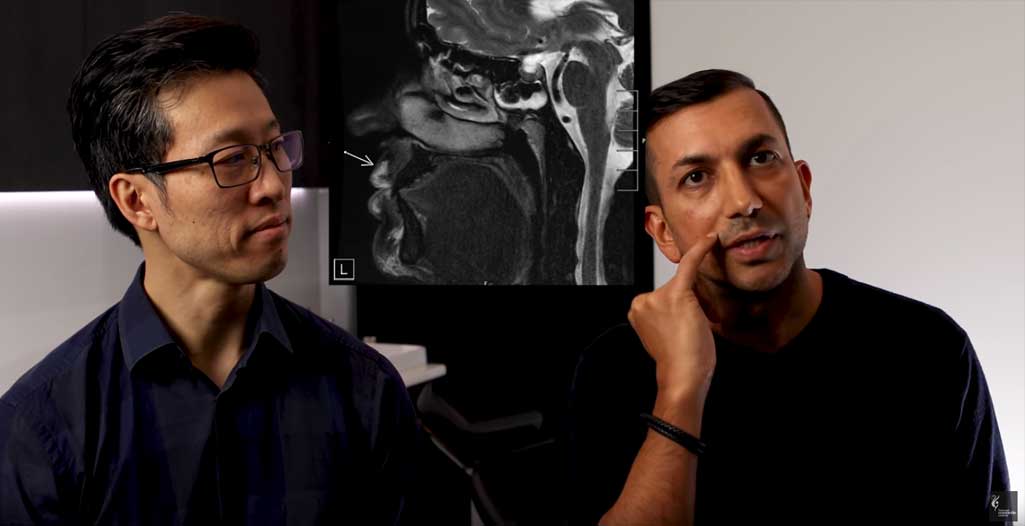How long do dermal fillers really last? MRI scans provide evidence
Over the last couple of decades dermal fillers have become a popular non-surgical method to enhance the lips, face, cheeks and brow area. Composed of hyaluronic acid, a substance that’s naturally found in the body, people are using fillers to help the appearance of the natural ageing process.
Over time, as facial movement increases in areas like the lips or cheeks, it causes the filler to break down and dissolve at a quicker rate. This makes the filler disappear faster in more active areas of the face.
So how long do dermal fillers last? Dr Gavin Chan and Dr Mobin Master discuss the longevity of dermal fillers, what affects dermal filler longevity, what you need to ask before getting dermal filler treatment and surprising evidence detected from an MRI scan. Keep reading to find out more.
What do dermal fillers do?
As we age, our skin loses elasticity, and the muscles and fat on our faces start thinning too. This results in the appearance of sagging skin and wrinkles.
Filler can address signs of ageing by smoothing out fine lines, wrinkles and laugh lines, restoring volume loss in the face and plumping up the skin.
Fillers are commonly made of hyaluronic acid, a naturally occurring substance in our bodies that aids in the production of elastin and collagen. Filler treatment has long been considered a minimally invasive procedure, requiring minimal downtime, is temporary and reversible. As a result, skin has structure, looks more plump and hydrated.
How long do dermal fillers last?
For the last 15 years Dr Gavin Chan (MBBS, Cosmetic Doctor, Liposuctionist) and his team of highly trained and experienced Cosmetic Doctors and Cosmetic Nurses have been treating patients using dermal fillers.
In the last year Dr Gavin Chan has discovered something about dermal fillers that has ‘blown him away’ regarding filler longevity. He explains, “traditionally we’ve been told that fillers last for between 6 and 12 months, perhaps 18 months. If you search the Internet, ask other Cosmetic Doctors who regularly inject fillers and then ask patients about how long fillers last, the answer is usually the same; 6, 12 or 18 months.”
But over the last few months, Dr Gavin Chan has started to question how long fillers actually last. This trailblazing enquiry began when he noticed patients who had tear trough dermal filler treatment a few years ago who came back from follow up dermal filler treatments. Many of them came in worried that they had puffy bulges under their eyes, with some patients putting it down to the natural ageing process.
After seeing this pattern occurring a few times, Dr Gavin Chan decided to research why this was happening. He hypothesised that maybe there were dermal fillers still present that created the bulging eye bag appearance. To see if this was the case, he used hyaluronidase (a dermal filler dissolver) and almost miraculously the eye bulges disappeared.
While Dr Gavin Chan knew it could be dermal filler present (sometimes after 6, 7 or 8 years) he needed to have scientific proof. Some dermal filler brands estimate that fillers only last 6 to 12 months, so Dr Gavin Chan decided to refer his patients for a Magnetic Resonance Imaging (MRI) scan to his colleague Dr Mobin Master (MBBS FRANZCR). Dr Mobin Master is qualified in both Radiology and Cosmetic Medicine and was the perfect Doctor to investigate these types of dermal filler issues. Dr Mobin Master explains, “I think MRI is an underused tool in Cosmetic Medicine. Using this tool enables us to see exactly where the dermal filler is present in the lips, cheeks and eye areas.”

What affects the longevity of filler?
There are a number of factors that affect dermal filler longevity, though this differs from person to person. Generally, areas with more movement tend to break down faster in comparison to other areas of the face with less movement.
Lifestyle factors like smoking and exercise can affect the longevity of dermal filler. Smoking may also impact the longevity of filler due to the constant muscle contraction and pursing of the lips. If you have a high metabolic rate, it is likely that the dermal filler will metabolise faster. This is commonly seen in people who workout regularly, as exercise increases the metabolic rate, it leads to filler being metabolised quicker.
Other factors that can contribute to filler longevity is where the filler was injected, how much was injected and the speed at which your body metabolises filler treatment. In the first few months after getting dermal filler, it will begin to slowly degrade, but the visible results will remain the same because fillers absorb water.
One of Dr Gavin Chan’s patients had received quite a few millilitres of dermal filler in her lips. After referring her for an MRI to Dr Mobin Master, it was clear there was dermal filler still present in the bottom and top part of the lip. The MRI also revealed that the dermal filler had migrated upwards above the lip line and below her nose. This MRI image confirmed what Dr Gavin Chan and Dr Mobin Master have noticed in the last few years, that filler migration can occur.
With the popularity of dermal filler treatment rising and the increasing number of clinics offering ‘cut-price’ dermal treatment with poor injection technique, results in people having too much filler injected into a particular area, like the lips, leading to a duck-like protrusion.
The MRI scan confirmed that there was too much lip filler migration. Dr Gavin Chan explains, “I see this as the new frontier of Cosmetic Medicine. We’re clearly seeing lip filler migration upwards towards the nose. When patients come back to me after 3 weeks of having dermal lip filler treatment and say that the dermal filler has ‘all gone’, I now know it hasn’t just dissolved.”
In the past, Dr Gavin Chan and his team would have agreed with the patient and proceeded to inject more filler into the lips. Instead, the Cosmetic Doctors and Cosmetic Nurses will dissolve the dermal filler before injecting new dermal filler into the lips.
Facts that all Cosmetic Doctors and Cosmetic Nurses must consider before injecting dermal fillers
1. More dermal filler treatments are not the answer
With more people deciding to get dermal filler treatments, there is a common misconception that ‘the more dermal fillers they have injected, the better.’ Combine this with the increased popularity and effect of social media influencers having non-surgical cosmetic treatments, it’s no wonder patients can start to believe this. Dr Mobin Master notes, “the problem with dermal fillers is that patients forget what they look like before they have them.” He reminds his patients what they looked like before their dermal injections and advises them that more dermal filler doesn’t result in a better-looking face. He also cautions his patients who have developed a bulge above the lip to get the injectable fillers dissolved before new filler injections.
Dr Gavin Chan states, “patients are becoming acclimated to getting more and more dermal filler. A good Cosmetic Doctor or Cosmetic Nurse working at a reputable medical clinic which primarily performs these non-surgical procedures will have had the training and experience to keep their patient’s ‘in line’. They’ll be able to recommend with kindness that they’ve had enough dermal filler for now.” He cautions that the Cosmetic Medicine industry can be driven purely by money and profit making which can result in patients being unconsciously coerced into getting more dermal filler treatments.
2. Lip fillers migrate
With evidence from the MRI scans showing that lip fillers can migrate upward, Dr Gavin Chan theorises that this is due to the mouth being very active, particularly the orbicularis oris muscle which controls movements of the mouth and lips. As this muscle is constantly contracting, it makes sense that over time the fillers could migrate north as a result of this lip movement. While MRI scans can be expensive, many patients consider it a worthwhile investment to work out what’s going on.
3. Dermal filler eye treatments can also migrate
Over the last 12 months Dr Gavin Chan has been referring patients to Dr Mobin Master, particularly when he needs to know if the swelling under the eyes is a result of old dermal filler or fat deposits. It’s important to determine whether the migrated filler is a result of dermal treatment, which can be dissolved. However, if it’s fat, patients can consider eyelid surgery (Blepharoplasty).
4. Dermal filler can last longer than expected
Dr Mobin Master notes that dermal filler can last a lot longer than the dermal filler brands say it will. He explains that overusing dermal filler in the face can result in a ‘chipmunk’ style face – the direct opposite of what most patients are striving for.
Dr Gavin Chan has noticed when patients he saw a few years ago come back after seeing other practitioners, their face has expanded, looking watery and swollen. Constantly adding dermal filler to the face results in a swollen-looking face, that’s not natural and not the desired look that patients were after. Over time, patients don’t notice that their face looks swollen and unnatural.
Dr Gavin Chan’s ground-breaking revelations over the past 12 months has changed the way all Cosmetic Doctors and Cosmetic Nurses at his clinics inject dermal fillers. By seeing his patient’s MRI scans he now believes that a minimalist approach to injecting dermal fillers creates better results.
He notes, “a few years ago it was thought that 1ml of dermal filler is exactly how much filler would be used for one part of the face: 1ml for lip fillers and 1ml for the cheek area. Today I’m only using 1ml of dermal filler for the entire face. I’m also only treating patients with dermal filler every 12 months or so – which provides natural results. They get their desired results, but without the swollen, unnatural look.”
Dr Mobin Master agrees stating, “we should take a lot more care with dermal fillers and really treat them as a semi-permanent non-surgical treatment. Some dermal filler brands don’t last as long as others. And once fillers have been in the face for a year or so, it can become harder to dissolve them with hyaluronidase. This is where I send patients to get MRI’s so I can ascertain where the fillers are.”
Dr Gavin Chan recommends dermal fillers to be reviewed every 12 months to confirm that patients are still happy with how they look. However, if the dermal filler treatment hasn’t met their expectations, it can be dissolved.
Questions all patients must ask before getting dermal filler treatment
With the growing demand for non-surgical treatments, it’s important to do your research. We suggest you only consider getting dermal filler treatment at a reputable medical clinic who have a team of highly trained and experienced Cosmetic Doctors and Cosmetic Nurses.
Questions all patients should ask include:
- What training and experience have they had?
- Do they know how to dissolve dermal fillers if you don’t like the result?
- Are they aware of the side effects of dermal fillers (including blindness)?
- How long will the dermal filler last?
- Is it permanent or semi-permanent?
- What’s the long-term effect going to be on your face if you keep injecting dermal filler into it?
- Would having less dermal filler injections make you look more natural?
- Where could the filler migrate to if you keep having dermal filler injections?
- How can you prevent migration from happening?
- What are your emergency protocols for cosmetic injectable treatments?
Where to get dermal filler treatment in Melbourne
Led by Dr Gavin Chan, his team of highly experienced and trained Cosmetic Doctors and Cosmetic Nurses have successfully treated thousands of patients with dermal filler since 2005. Call our friendly customer service team to book a consultation today 1300 863 824 or book online.
